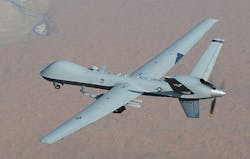Spending for U.S. military UAVs to rise from $4.97 billion in 2013 to $6.53 billion in 2018
MOUNTAIN VIEW, Calif., 7 May 2014. Spending for U.S. military unmanned aerial vehicles (UAVs) will rise from $4.97 billion in 2013 to $6.53 billion in 2018 -- a five-year increase of 24 percent -- predict analysts at market researcher Frost & Sullivan in Mountain View, Calif.
UAVs remain essential for conducting intelligence, surveillance, reconnaissance and strike operations, despite the withdrawal and reduction of troops from Iraq and Afghanistan, analysts forecast.
Still, analysts recommend that companies involved in UAV manufacturing and support should keep a close eye on opportunities in foreign military and the global commercial UAV market to stay afloat, as U.S. Department of Defense (DOD) budgets for UAVs decline.
Frost & Sullivan analysts outline their findings in the Analysis of the U.S. DOD Unmanned Aerial Systems Market, which points out that a large part of anticipated UAV spending increases is due to research for unmanned long-range strike bombers.
Related: Teal: worldwide spending for unmanned aerial vehicles (UAVs) to double over next decade
If budget constraints hit the Pentagon's research funding, analysts caution, UAV spending by 2018 by reach only $3.7 billion to $4 billion.
The high costs of developing new unmanned aerial systems, as well as shrinking DOD budgets, are combining to squeeze the UAV industry over the next five years, analysts say. These conditions are forcing manufacturers to modify existing unmanned aircraft and systems rather than developing new ones.
Increasing use of rugged commercial off-the-shelf (R-COTS) components and subsystems in UAVs and UAV control stations is intensifying competition in this market, analysts point out. Companies that can create modular, size, weight and power (SWaP)-efficient UAV sensors and subsystems will remain competitive.
Related: Pentagon plans to spend $2.45 billion next year on UAVs for surveillance and attack
Electronic warfare, cargo transport, atmospheric satellites, and identifying intercontinental ballistic missile launches in boost phase are other emerging uses of UAVs. Some of these applications will require further testing and validation to ensure UAV platforms can satisfy requirements.
For more information contact Frost & Sullivan online at www.frost.com.

